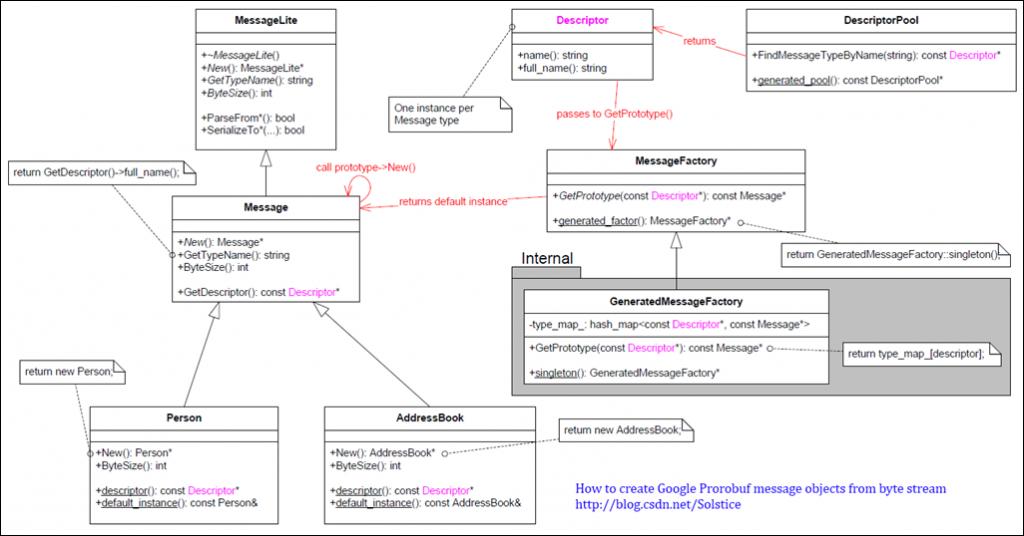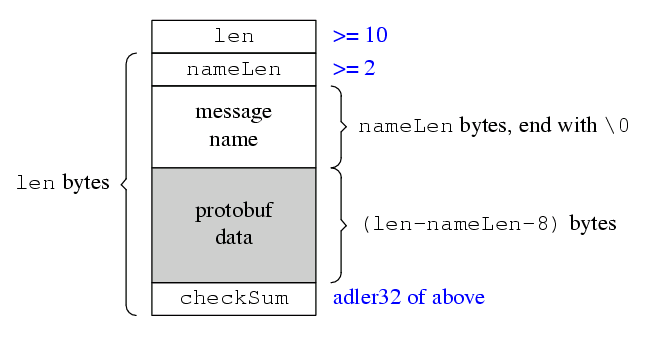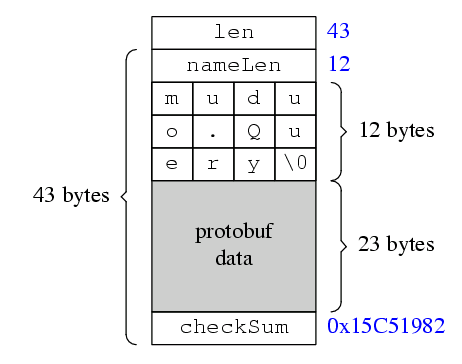這篇文章要解決的問題是:在接收到 protobuf 數據之後,如何自動創建具體的 Protobuf Message 對象 ,再做的反序列化。“自動”的意思是:當程序中新增一個 protobuf Message 類型時,這部分代碼不 需要 修改,不需要自己去注冊消息類型。其實,Google Protobuf 本身具有很強的反射(reflection)功能, 可以 根據 type name 創建具體類型的 Message 對象,我們直接利用即可。
本文假定讀者了解 Google Protocol Buffers 是什麼,這不是一篇 protobuf 入門教程。
本文以 C++ 語言舉例,其他語 言估計 有類似的解法,歡迎補充。
本文的示例代碼在: https://github.com/chenshuo/recipes/tree/master/protobuf
網絡編程中使用 protobuf 的兩個問題
Google Protocol Buffers (Protobuf) 是一款非常優秀的庫,它定義了一種緊湊的可擴展二進制消 息格 式,特別適合網絡數據傳輸。它為多種語言提供 binding,大大方便了分布式程序的開發,讓系統不再 局限 於用某一種語言來編寫。
在網絡編程中使用 protobuf 需要解決兩個問題:
長度,protobuf 打包的數據沒有自帶長度信息或終結符,需要由應用程序自己在發生和接收的時候 做正 確的切分;
類型,protobuf 打包的數據沒有自帶類型信息,需要由發送方把類型信息傳給給接收方,接收方創 建具 體的 Protobuf Message 對象,再做的反序列化。
第一個很好解決,通常的做法是在每個消息前面加個固定長度的 length header,例如我在 《Muduo 網 絡編程示例之二: Boost.Asio 的聊天服務器》 中實現的 LengthHeaderCodec,代碼見 http://code.google.com/p/muduo/source/browse/trunk/examples/asio/chat/codec.h
第二個問題其實也很好解決,Protobuf 對此有內建的支持。但是奇怪的是,從網上簡單搜索的情況 看, 我發現了很多山寨的做法。
山寨做法
以下均為在 protobuf data 之前加上 header,header 中包含 int length 和類型信息。類型信息 的山 寨做法主要有兩種:
在 header 中放 int typeId,接收方用 switch-case 來選擇對應的消息類型和處理函數;
在 header 中放 string typeName,接收方用 look-up table 來選擇對應的消息類型和處理函數。
這兩種做法都有問題。
第一種做法要求保持 typeId 的唯一性,它和 protobuf message type 一 一對應。如果 protobuf message 的使用范圍不廣,比如接收方和發送方都是自己維護的程序,那麼 typeId 的唯一性不難保證,用版本管理工具即可。如果 protobuf message 的使用范圍很大,比如全公司都在 用, 而且不同部門開發的分布式程序可能相互通信,那麼就需要一個公司內部的全局機構來分配 typeId, 每次增 加新 message type 都要去注冊一下,比較麻煩。
第二種做法稍好一點。typeName 的唯一性比 較好 辦,因為可以加上 package name(也就是用 message 的 fully qualified type name),各個部門事 先分 好 namespace,不會沖突與重復。但是每次新增消息類型的時候都要去手工修改 look-up table 的初 始化代 碼,比較麻煩。
其實,不需要自己重新發明輪子,protobuf 本身已經自帶了解決方案。
根據 type name 反射自動創建 Message 對象
Google Protobuf 本身具有很強的反射(reflection)功能,可以根據 type name 創建具體類型的 Message 對象。但是奇怪的是,其官方教程裡沒有明確提及這個用法,我估計還有很多人不知道這個用 法, 所以覺得值得寫這篇 blog 談一談。
以下是陳碩繪制的 Protobuf class diagram。

我估計大家通常關心和使用的是圖的左半部分:MessageLite、Message、Generated Message Types (Person, AddressBook) 等,而較少注意到圖的右半部分:Descriptor, DescriptorPool, MessageFactory 。
上圖中,其關鍵作用的是 Descriptor class,每個具體 Message Type 對應一個 Descriptor 對 象。盡管我們沒有直接調用它的函數,但是Descriptor在“根據 type name 創建具體類型的 Message 對象 ”中扮演了重要的角色,起了橋梁作用。上圖的紅色箭頭描述了根據 type name 創建具體 Message 對 象的 過程,後文會詳細介紹。
原理簡述
Protobuf Message class 采用了 prototype pattern,Message class 定義了 New() 虛函數,用 以返回 本對象的一份新實例,類型與本對象的真實類型相同。也就是說,拿到 Message* 指針,不用知道它的 具體 類型,就能創建和它類型一樣的具體 Message Type 的對象。
每個具體 Message Type 都有一個 default instance,可以通過 ConcreteMessage::default_instance () 獲得,也可以通過 MessageFactory::GetPrototype(const Descriptor*) 來獲得。所以,現在問題 轉變 為 1. 如何拿到 MessageFactory;2. 如何拿到 Descriptor*。
當然, ConcreteMessage::descriptor() 返回了我們想要的 Descriptor*,但是,在不知道 ConcreteMessage 的時 候,如何調用它的靜態成員函數呢?這似乎是個雞與蛋的問題。
我們的英雄是 DescriptorPool ,它 可以根據 type name 查到 Descriptor*,只要找到合適的 DescriptorPool,再調用 DescriptorPool::FindMessageTypeByName(const string& type_name) 即可。眼前一亮?
在最 終解決問題之前,先簡單測試一下,看看我上面說的對不對。
簡單測試
本文用於舉例的 proto 文件:query.proto,見 https://github.com/chenshuo/recipes/blob/master/protobuf/query.proto
package muduo;
message Query {
required int64 id = 1;
required string questioner = 2;
repeated string question = 3;
}
message Answer {
required int64 id = 1;
required string questioner = 2;
required string answerer = 3;
repeated string solution = 4;
}
message Empty {
optional int32 id = 1;
}
其中的 Query.questioner 和 Answer.answerer 是我在前一篇文章這提到的《分布式系 統中的 進程標識》。
以下代碼驗證 ConcreteMessage::default_instance()、ConcreteMessage::descriptor()、 MessageFactory::GetPrototype()、DescriptorPool::FindMessageTypeByName() 之間的不變式 (invariant):
https://github.com/chenshuo/recipes/blob/master/protobuf/descriptor_test.cc#L15
typedef muduo::Query T; std::string type_name = T::descriptor()->full_name(); cout << type_name << endl; const Descriptor* descriptor = DescriptorPool::generated_pool()->FindMessageTypeByName (type_name); assert(descriptor == T::descriptor()); cout << "FindMessageTypeByName() = " << descriptor << endl; cout << "T::descriptor() = " << T::descriptor() << endl; cout << endl; const Message* prototype = MessageFactory::generated_factory()->GetPrototype(descriptor); assert(prototype == &T::default_instance()); cout << "GetPrototype() = " << prototype << endl; cout << "T::default_instance() = " << &T::default_instance() << endl; cout << endl; T* new_obj = dynamic_cast(prototype->New()); assert(new_obj != NULL); assert(new_obj != prototype); assert(typeid(*new_obj) == typeid(T::default_instance())); cout << "prototype->New() = " << new_obj << endl; cout << endl; delete new_obj;
根據 type name 自動創建 Message 的關鍵代碼
好了,萬事具備,開始行動:
用 DescriptorPool::generated_pool() 找到一個 DescriptorPool 對象,它包含了程序編譯的 時候所 鏈接的全部 protobuf Message types。
用 DescriptorPool::FindMessageTypeByName() 根據 type name 查找 Descriptor。
再用 MessageFactory::generated_factory() 找到 MessageFactory 對象,它能創建程序編譯的 時候 所鏈接的全部 protobuf Message types。
然後,用 MessageFactory::GetPrototype() 找到具體 Message Type 的 default instance。
最後,用 prototype->New() 創建對象。
示例代碼見 https://github.com/chenshuo/recipes/blob/master/protobuf/codec.h#L69
Message* createMessage(const std::string& typeName)
{
Message* message = NULL;
const Descriptor* descriptor = DescriptorPool::generated_pool()->FindMessageTypeByName
(typeName);
if (descriptor)
{
const Message* prototype = MessageFactory::generated_factory()->GetPrototype
(descriptor);
if (prototype)
{
message = prototype->New();
}
}
return message;
}
調用方式: https://github.com/chenshuo/recipes/blob/master/protobuf/descriptor_test.cc#L49
Message* newQuery = createMessage("muduo.Query");
assert(newQuery != NULL);
assert(typeid(*newQuery) == typeid(muduo::Query::default_instance()));
cout << "createMessage(/\"muduo.Query/\") = " << newQuery <<
endl;
古 之人不余欺也 :-)
注意,createMessage() 返回的是動態創建的對象的指針,調用方有責任釋 放它, 不然就會內存洩露。在 muduo 裡,我用 shared_ptr 來自動管理 Message 對象的生命期。
線 程安全 性
Google 的文檔說,我們用到的那幾個 MessageFactory 和 DescriptorPool 都是線程安全的, Message::New() 也是線程安全的。並且它們都是 const member function。
關鍵問題解決了, 那麼 剩下工作就是設計一種包含長度和消息類型的 protobuf 傳輸格式。
Protobuf 傳輸格式
陳碩設計了一個簡單的格式,包含 protobuf data 和它對應的長度與類型信息,消息的末尾還有 一個 check sum。格式如下圖,圖中方塊的寬度是 32-bit。

用 C struct 偽代碼描述:
struct ProtobufTransportFormat __attribute__
((__packed__))
{
int32_t len;
int32_t nameLen;
char typeName[nameLen];
char protobufData[len-nameLen-8];
int32_t checkSum; // adler32 of nameLen, typeName and protobufData
};
注意,這個格式不要求 32-bit 對齊,我們的 decoder 會自動處理非對齊的消息。
例子
用這個格式打包一個 muduo.Query 對象的結果是:

查看本欄目
設計決策
以下是我在設計這個傳輸格式時的考慮:
signed int。消息中的長度字段只使用了 signed 32-bit int,而沒有使用 unsigned int,這是 為了移 植性,因為 Java 語言沒有 unsigned 類型。另外 Protobuf 一般用於打包小於 1M 的數據,unsigned int 也沒用。
check sum。雖然 TCP 是可靠傳輸協議,雖然 Ethernet 有 CRC-32 校驗,但是網絡傳輸必須要考 慮數 據損壞的情況,對於關鍵的網絡應用,check sum 是必不可少的。對於 protobuf 這種緊湊的二進制格 式而 言,肉眼看不出數據有沒有問題,需要用 check sum。
adler32 算法。我沒有選用常見的 CRC-32,而是選用 adler32,因為它計算量小、速度比較快, 強度和 CRC-32差不多。另外,zlib 和 java.unit.zip 都直接支持這個算法,不用我們自己實現。
type name 以 '\0' 結束。這是為了方便 troubleshooting,比如通過 tcpdump 抓下來 的包可 以用肉眼很容易看出 type name,而不用根據 nameLen 去一個個數字節。同時,為了方便接收方處理 ,加入 了 nameLen,節省 strlen(),空間換時間。
沒有版本號。Protobuf Message 的一個突出優點是用 optional fields 來避免協議的版本號(凡 是在 protobuf Message 裡放版本號的人都沒有理解 protobuf 的設計),讓通信雙方的程序能各自升級, 便於系 統演化。如果我設計的這個傳輸格式又把版本號加進去,那就畫蛇添足了。具體請見本人《分布式系統 的工 程化開發方法》第 57 頁:消息格式的選擇。
示例代碼
為了簡單起見,采用 std::string 來作為打包的產物,僅為示例。
打包 encode 的代碼: https://github.com/chenshuo/recipes/blob/master/protobuf/codec.h#L35
解包 decode 的代碼: https://github.com/chenshuo/recipes/blob/master/protobuf/codec.h#L99
測試代碼: https://github.com/chenshuo/recipes/blob/master/protobuf/codec_test.cc
如果以上代碼編譯通過,但是在運行時出現“cannot open shared object file”錯誤,一般可以 用 sudo ldconfig 解決,前提是 libprotobuf.so 位於 /usr/local/lib,且 /etc/ld.so.conf 列出了這 個目 錄。
$ make all # 如果你安裝了 boost,可以 make whole
$ ./codec_test
./codec_test: error while loading shared libraries: libprotobuf.so.6: cannot open shared object file: No such file or directory
$ sudo ldconfig
與 muduo 集 成
muduo 網絡庫將會集成對本文所述傳輸格式的支持(預計 0.1.9 版本),我會另外寫一篇短文介 紹 Protobuf Message <=> muduo::net::Buffer 的相互轉化,使用 muduo::net::Buffer 來打包比 上面 std::string 的代碼還簡單,它是專門為 non-blocking 網絡庫設計的 buffer class。
此外, 我們 可以寫一個 codec 來自動完成轉換,就行 asio/char/codec.h 那樣。這樣客戶代碼直接收到的就是 Message 對象,發送的時候也直接發送 Message 對象,而不需要和 Buffer 對象打交道。
消息的分發 (dispatching)
目前我們已經解決了消息的自動創建,在網絡編程中,還有一個常見任務是把不同類型的 Message 分發 給不同的處理函數,這同樣可以借助 Descriptor 來完成。我在 muduo 裡實現了 ProtobufDispatcherLite 和 ProtobufDispatcher 兩個分發器,用戶可以自己注冊針對不同消息類型的處理函數。預計將會在 0.1.9 版本發布,您可以先睹為快:
初級版,用戶需要自己做 down casting: https://github.com/chenshuo/recipes/blob/master/protobuf/dispatcher_lite.cc
高級版,使用模板技巧,節省用戶打字: https://github.com/chenshuo/recipes/blob/master/protobuf/dispatcher.cc
基於 muduo 的 Protobuf RPC?
Google Protobuf 還支持 RPC,可惜它只提供了一個框架,沒有開源網絡相關的代碼,muduo 正好 可以 填補這一空白。我目前還沒有決定是不是讓 muduo 也支持以 protobuf message 為消息格式的 RPC, muduo 還有很多事情要做,我也有很多博客文章打算寫,RPC 這件事情以後再說吧。
注:Remote Procedure Call (RPC) 有廣義和狹義兩種意思。狹義的講,一般特指 ONC RPC,就是用來實現 NFS 的那個東西; 廣義 的講,“以函數調用之名,行網絡通信之實”都可以叫 RPC,比如 Java RMI,.Net Remoting,Apache Thrift,libevent RPC,XML-RPC 等等。